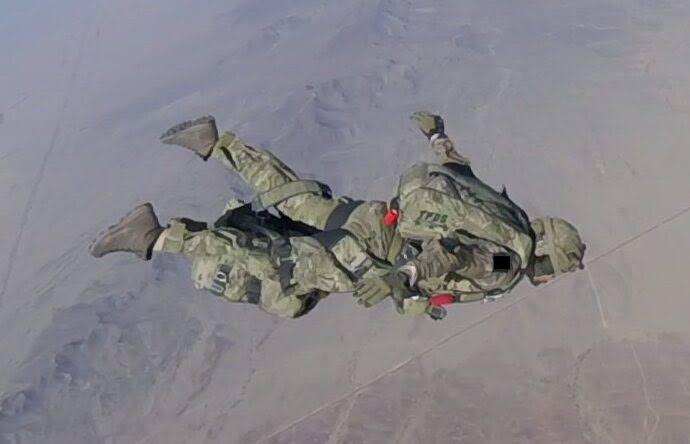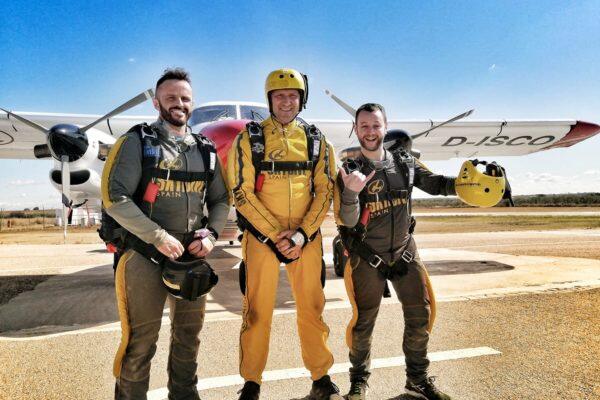-
Content
18 -
Joined
-
Last visited
-
Feedback
N/A -
Country
India
Posts posted by randhawa922
-
-
2 hours ago, JoeWeber said:Yes. And not just for you but for everyone else who believes going to the internet first and talking to experts second is appropriate: stop it. That is not to say that the voracious reading of articles and research online isn't a fantastic way to learn. Just do not expect that opinions from all comers on blogs is a good first start. It is not, in fact it's the worse way to start.
Thank you for your inputs sir.. appreciated.
-
6 hours ago, JoeWeber said:With respect sir,
You need to hire someone with deep experience and knowledge rather than seeking solutions online. It's not just asking how to make a successful exit with a student at high exit speeds, imagine what might happen if two inexperienced instructors tumble an AFF 1 at 250kph or if the pilot turns on the light at 300 kph. Surely there is someone you can access for knowledge if these jumps are even necessary and unless it's some kind of special forces training I can not imagine why it would be.
I understand, I believe your advice. I’m just gathering general information. Regards.
-
On 1/12/2023 at 1:00 AM, riggerrob said:What types of aircraft are the Indian Air Force using to train AFF?
Illyushin IL-76, C-130 and C-17 are too fast for graceful AFF. Once students progress beyond the first few harness-hold jumps, these would be fine for later practice jumps especially with rucksack, rifle and snowshoes.
How many Antonov AN-32 are still in Indian Air Force service? How slow can an AN-32 fly jump-run with a light load (say half fuel) and the cargo ramp open?
I have done tandems from Dornier 228, but that side door is a bit low for AFF. The Dornier factory-supplied aluminum, accordian-fold door is a nuisance. You would be better off without or with a modern slide-up door made of clear Lexan (see most North American civilian jump-planes). You would also want to add grab rails both inside and outside the top edge of the door. I have done plenty of harness-hold jumps from Beechcraft King Air, with a similar-sized door, but the medium-sized door is far from ideal. Those medium-sized side doors are silly for jumping with rucksacks.
Mi-8 and Mi-17 helicopters would be perfect. Just tell the pilots to open the cargo ramp and fly jump-run at 80 to 100 knots. Harness-hold jumps are easy at those airspeeds.
HAL Chetak and HAL Dhruv helicopters would be fine for smaller AFF classes, because they only carry 1 or 3 AFF teams at a time, but still tell pilots to fly jump run at 80 to 100 knots. How tall is the tail ramp on Dhruv?
In summary, slow-flying (80 to 100 knots) aircraft with cargo ramps are the first choice for AFF. Slow-flying aircraft with tall side doors (say 1.5 to 2 meters) are second choice, but require more setting-up outside the door before letting go.
Finally even a half hour in a wind tunnel will vastly improve and AFF program. Are there any vertical wind tunnels in India?
As an aside, I have jumped from more than 30 different types of aircraft .. some cramped ... some comfortable ... some easy to exit ... some a struggle to exit ...
Airvan, Breezy, Beechcraft D-18 (3 different-sized doors), Queen Air and King Air, Britten-Norman Islander, Cessna 172, 180, 182, 185, 205, 206P, Soloy Turbine 206U, 207, 208, 210 and a light twin, DC-3 Dakota, deHavilland DHC-4 Cariboo, DHC-5 Buffalo, DHC-6 Twin Otter, Dornier 27 and 228, Ford Tri-Motor, C-130 Hercules, Maule, Pilatus Porter, Piper Cherokee Six, Quest Kodiak, Shorts Skyvan and Skyliner, and Westwind conversion of Beech 18.
Helicopters include: Aerospatiale Alouette II and A-Star, Bell Huey and Jet Ranger finally CH-47 Chinook.
Thank you for sharing valuable information !!
-
MFF (Military Free Fall) Training around the world
Hellos.. wanted to know how world forces get their MFF jumpers trained nowadays.
Is it like USPA AFF method, or traditional ground training + tunnel exposure & then solos ? How is it at your place ?
This video of US Forces, in this instructors are jumping as AFFIs or they are just stand by in case of emergency with trainees ? Please share knowledge.. Blue Skies!
-
Yeah.. thank you!! Blue skies!!
-
Hi. I got some new Aerodyne Triathlons. While attaching toggles, there is no loop at the end of the control lines. How that has to be done? Any guiding document? Is it to be done like this PD video ?
-
On 1/9/2023 at 6:00 PM, randhawa922 said:If anyone has any literature/article or documentary information on this, request share.
-
 1
1
-
-
1 hour ago, sfzombie13 said:don't they use c-130s for mff training in the desert? or do they use civilian aircraft? i know an instructor who was there several years ago and i thought he mentioned using a c-130 but it's been years since i talked to him. i know that during airborne ops the c-17 can't slow down enough to let jumpers out unless it has less than half a tank of fuel, and when we jumped it was going at about 170 knts. that was static line and not mff though.
Haven’t seen AFF from C-130/C-17 in any case.
-
9 hours ago, chuckakers said:Why even ask the question? Any entity that can afford high speed aircraft can also afford aircraft that can be safely flown at slower speeds. There is simply no need to complicate things.
If you require tailgate birds for tactical military freefall exits, just acquire tailgate aircraft like the Skyvan for initial training. This has been a routine practice for military freefall training for years.
You’re right.
So fast moving aircraft is not used for AFF. Thanks!
-
12 hours ago, billvon said:What is kmph? Is that kph or mph or kts (knots?)
If you are talking kps then it's more difficult but it's doable, especially with tailgates. 250kph would be 135kts, which is pretty close to standard exit speed on a C130 (125kts.)
Kmph-Kilometers per hour, yes, It is 135Kts. Doable, okay. But is it in practice anywhere in the world?
-
12 hours ago, billvon said:Yes. A rapid pressurization (or depressurization) will cause the cypres to think that it is climbing or descending faster than is physically possible, and it will throw an error and shut down. This happened to some cypreses during the WT jumps when the aircraft pressurized.
Not unless you power cycle it.
Never. The one time it happened to me was a screwup.
Ok, but it can be resorted to for specific requirement and it doesn’t impact functionality of CYPRES
-
-
19 hours ago, pchapman said:Seems OK by the manual. Cypres would just get fooled if you started at "ground level" then during the climb the pressure went to below ground level. (Special case: If a DZ offset is set, then the limit is that new level, not zero.)
So climbing to 3000', starting to pressurize and going to a cabin altitude of 3000' minimum (or even dipping down to say 2000'), and then climbing to altitude with the cabin altitude only slowly ascending or level at some value, before eventually depressurizing.... That's little different to a Cypres than climbing in a regular aircraft to 3000', ducking down lower because of some clouds, and then climbing to altitude.
But question #3 makes one wonder what the original poster's skydiving experience is... Since basically nobody uses pressurization unless you are on some very rare, unusual world record with exotic aircraft. It doesn't apply for 99.9999% of skydives.
Haha.. It applies to several military ops. Thank you! Blue skies!!
-
Hey folks thank you so much. I have adequate experience and my question 3 was genuine, the environment I am working right now requires pressurisation at times.
We can definitely pressurise crossing arming altitude of respective CYPRES models. It doesn’t change ground elevation value obtained during intial self integtest.
Thank you and blue skies!!!
-
Hello everyone!
Please throw some light on following questions:1. What if the cabin is pressurised after climbing & crossing 3000 feet AGL(considering safe margin) for an expert CYPRES II or for any other CYPRES model? Cabin pressure maintained 3000 feet AGL or above until exit. Exit from 10,000 feet AGL. Does it impact functionality?
2. CYPRES calculates during initial self integrated test and obtains ground elevation value. If cabin is pressurised after climbing 3000 feet AGL & again maintained 3K or above, does it impact on ground elevation value which CYPRES obtained during self integrated test?
3. How often do you resort to cabin pressurisation for longer duration flights after crossing arming altitude ?
-
Anyone can share experience in difference between opening impact of a ZP & F1.11 please....
-
http://www.skydivedubai.ae/hotel-at-skydive-dubai-desert-campus-now-open/
Accomodation is available at DZ.






Do military static line jumps count toward jump numbers or just mil. freefall jumps?
in General Skydiving Discussions
So do they count or not… ?
I am an MFFI, Static liner, sport skydiver, demos, HALOs etc.. please enlighten)) @riggerrob